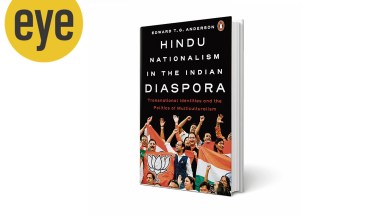In Hindu Nationalism in the Indian Diaspora, historian Edward Anderson traces the rise and proliferation of right-wing fervour in Indian communities abroad
An excellent work, it explores the conception of a Hindu rashtra with cultural revivalism and unimaginative Hindutva at the heart of it

The rise of right-wing political parties across the globe is a phenomenon which is the distillation of a political process not confined by political boundaries. Transnationalism forms an important sine qua non of national political ideologies. It is thus not surprising that more than 65 per cent of Turks living in Germany voted for Erdogan in the 2018 Turkish presidential elections. Similarly, the traditional Hungarian diaspora in the UK supports Prime Minister (PM) Viktor Orban. The Indian PM Narendra Modi, too, has a large diasporic support, particularly in the US and UK.
This deeply researched book begins with the history of the inception of Hindu nationalism in the Indian diaspora, particularly in East Africa. A large part of the book deciphers the formation and rise of Bharatiya Swayamsevak Sangh (BSS), as Rashtriya Swayamsevak Sangh (RSS) was initially called overseas. In fact, Anderson writes that the first shakha of the BSS was inaugurated in Nairobi on January 14, 1947, just a year before Mahatma Gandhi was assassinated by an RSS man. This East African diaspora had an important role to play in the rise and activities of the Hindu Swayamsevak Sangh (HSS), which was formed in the UK in early 1970s. Anderson meticulously describes the working, composition and hierarchy of these outfits among Indian diaspora.
The landscape of Anderson’s book is populated with people and incidents which make us realise that the rise of Hindutva politics in the 1980s and 1990s culminating in the election of Modi in 2014 hasn’t come out of thin air. Hindu transnationalism is a long-drawn process of meticulous conceptualisation and planning. More than capturing power, the process of Hindu transnationalism helps in propagating the idea of an imagined past of India. Anderson has dissected this reality with the skill and craft of a surgeon. He traces the footprint of Hindu nationalism globally and lets us see the mammoth in skin and flesh.
Anderson feels that to understand the Sangh overseas, it is essential to consider the activities of diasporic swayamsevaks and karyakartas outside the countries in which they live. He also draws vital differences between the working of the RSS at home and its sister organisations in more demographically diverse, democratic and cosmopolitan countries like the UK. Anderson’s book, in one sense, reminded me of Akshaya Mukul’s Gita Press and the Making of Hindu India (2016), another scholarly treatise on the functioning of one of the cogwheels of Hindutva.
Anderson has correctly concluded that two events, namely the imposition of Emergency by Indira Gandhi (1975-77) and the Ram Janmabhoomi movement (in 1980s-90s), gave a shot in the arm to Sangh activities overseas. According to him, Britain was perhaps the most important of all overseas centres of Sangh activism but the size and impact of this activism remains unclear, more so because of misinformation and fake narrative.
Anderson describes in detail the formation and working of the most important progeny of the RSS namely the Vishwa Hindu Parishad (VHP). The regressive gender politics, militant cultural revivalism and collection and misappropriation of funds for Ayodhya’s Ram Mandir by the VHP form the mainstay of this description.
Anderson’s book is an excellent scholarly work which needs to be read by those who want to understand the conception of a Hindu rashtra with cultural revivalism and the unimaginative, brutal Hindutva at the heart of it. The cultivation and enhancement of “long distance nationalism” as a major goal of the RSS can best be understood in the light of “cultural renaissance”, which was always in the air, but picked up pace after 2014. This utilisation of Hindu diaspora in national politics has been quite holistic to say the least but it should be realised that the Indian diaspora globally lacks a nuanced dissection of social, political and economic issues back home.
Having said this, the book is repetitive in certain places and thus can be dreary at times. It would have been beneficial if the author had dealt with the economic analysis of the global Hindutva project since global transnationalism thrives on corporate funding to a significant extent.
Only time shall tell whether a secular India will arrive at the doorstep of theocracy or not, but the analysis of diasporic Hindutva, like the one by Anderson, is important because it shows readers how loyalty to a state has moved towards allegiance to religion and culture. This worrying trend not only weakens the diverse fabric of a laic nation but also opens up social confrontational possibilities for the majority community with long term generational consequences.
Khan is professor, Department of Orthopaedics, All India Institute of Medical Sciences, New Delhi. Views are personal